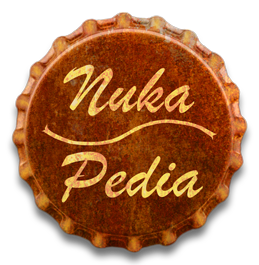"The Battle Hymn of the Republic," also known as "Mine Eyes Have Seen The Glory," is a patriotic song written by Julia Ward Howe, who used the music of "John Brown's Body" by William Steffe.
The song is played on Enclave Radio in Fallout 3, in the Museum of Freedom[1] and in Pulowski Preservation shelters[2] in Fallout 4. It is also played after the speech made by the Sole Survivor on the recruitment radio beacons. It can also be heard in "The Past", the fifth episode of the first season of the Fallout TV series.
The arrangement used in Fallout 3 was done by Kelly Richmond and was released in 1996 on the Sound Ideas CD Time Marches On. It was rereleased in 2003 on the Westar Music CD Proud and Spirited (WSR 171).[3]
Background[]
The "Glory, Hallelujah" tune was a folk hymn developed in the oral hymn tradition of camp meetings in the southern United States and first documented in the early 1800s. In the first known version, "Canaan's Happy Shore," the text includes the verse "Oh! Brothers will you meet me (3×)/On Canaan's happy shore?" and chorus "There we'll shout and give him glory (3×)/For glory is his own"; this developed into the familiar "Glory, glory, hallelujah" chorus by the 1850s. The tune and variants of these words spread across both the southern and northern United States. At a flag-raising ceremony at Fort Warren, near Boston, Massachusetts on Sunday, May 12, 1861, the John Brown song, using the well known "Oh! Brothers" tune and the "Glory, Hallelujah" chorus, was publicly played "perhaps for the first time." The American Civil War had begun the previous month.
In 1890, George Kimball wrote his account of how the 2nd Infantry Battalion of the Massachusetts militia, known as the "Tiger" Battalion, collectively worked out the lyrics to "John Brown's Body." According to Kimball, these sayings became by-words among the soldiers and, in a communal effort, were gradually put to the tune of "Say, Brothers."
Some leaders of the battalion, feeling the words were coarse and irreverent, tried to urge the adoption of more fitting lyrics, but to no avail. The lyrics were soon prepared for publication by members of the battalion, together with publisher C. S. Hall. They selected and polished verses they felt appropriate, and may even have enlisted the services of a local poet to help polish and create verses.
The official histories of the old First Artillery and of the 55th Artillery (1918) also record the Tiger Battalion's role in creating the John Brown Song, confirming the general thrust of Kimball's version with a few additional details.
Kimball's battalion was dispatched to Murray, Kentucky early in the Civil War, and Julia Ward Howe heard this song during a public review of the troops outside Washington D.C. on Upton Hill, Virginia. Rufus R. Dawes, then in command of Company "K" of the 6th Wisconsin Volunteer Infantry, stated in his memoirs that the man who started the singing was Sergeant John Ticknor of his company. Howe's companion at the review, The Reverend James Freeman Clarke, suggested to Howe that she write new words for the fighting men's song. Staying at the Willard Hotel in Washington on the night of November 18, 1861, Howe wrote the verses to the "Battle Hymn of the Republic." Of the writing of the lyrics, Howe remembered:
"I went to bed that night as usual, and slept, according to my wont, quite soundly. I awoke in the gray of the morning twilight; and as I lay waiting for the dawn, the long lines of the desired poem began to twine themselves in my mind. Having thought out all the stanzas, I said to myself, 'I must get up and write these verses down, lest I fall asleep again and forget them.' So, with a sudden effort, I sprang out of bed, and found in the dimness an old stump of a pen which I remembered to have used the day before. I scrawled the verses almost without looking at the paper."
Howe's "Battle Hymn of the Republic" was first published on the front page of The Atlantic Monthly of February 1862. The sixth verse written by Howe, which is less commonly sung, was not published at that time. The song was also published as a broadside in 1863 by the Supervisory Committee for Recruiting Colored Regiments in Philadelphia.
Both "John Brown" and "Battle Hymn of the Republic" were published in Father Kemp's Old Folks Concert Tunes in 1874 and reprinted in 1889. Both songs had the same chorus with an additional "Glory" in the second line: "Glory! Glory! Glory! Hallelujah!"
Julia Ward Howe was the wife of Samuel Gridley Howe, the famed scholar in education of the blind. Samuel and Julia were also active leaders in anti-slavery politics and strong supporters of the Union. Samuel Howe was a member of the Secret Six, the group who funded John Brown's work.
Notes[]
In Fallout 3, one can find Nathaniel Vargas humming the song.[4]
Video[]
References[]
- ↑ https://youtu.be/GrX-QT19Ro0?t=186
- ↑ In-game audio file of the music
- ↑ Battle Hymn of the Republic on Westar Music
- ↑ Nathaniel Vargas: [Humming a tune] {Humming "The Battle Hymn of the Republic".}
(Nathan's dialogue)

